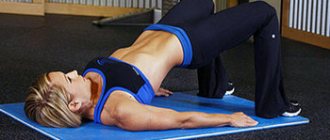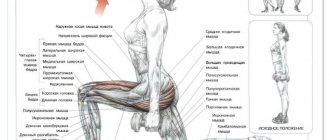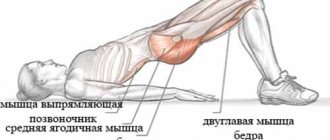Life's non-negotiable pairings: Tomatoes should be served with salt, biscotti should be eaten with espresso, and glute bridges should be included in your regular workout routine; any trainer will tell you that your glutes can greatly benefit from this movement.
The single-leg bridge option has advantages: the single-leg bridge not only helps isolate the glutes one at a time, but also engages the hamstrings more effectively than other exercises.
Read : How to warm up before training
Execution technique
You need to know how to do the exercise correctly, because if done incorrectly, a person may not get the desired result.
The exercise is performed as follows:
- Lie on the floor, pressing your lower back firmly to the floor. The foot of one leg is placed on the floor, and the second leg is straightened. Hands on the floor parallel to the body.
- Inhale and raise your lower back and hips to a straight line. The buttocks are tense at this moment. Stay in this position for a while.
- As you exhale, return to the starting position, but without touching the floor with your buttocks. After this, climb up again.
Perform 3-4 sets of 10-15 times on each leg. Thanks to this exercise, not only the shape of the buttocks is improved, but also the strength in the corresponding muscles increases.
The exercise is suitable even for people with joint diseases, since there is practically no load on them. The one-leg gluteal bridge is considered the second most difficult, after the classic one. Having mastered the exercise ideally, you can complicate it with sports equipment.
Execution options
Classic without weights
The technique is no different from that described above.
With elastic band
The simplest and most affordable weighting option. We wrote about performing this variation of the gluteal bridge in the article It’s realistic to pump up your buttocks at home: what exercises and equipment are available to you at home?
With pressing, bringing the knees together
This complication of actions will allow you to load your buttocks even more.
How to do it correctly: after you strain your buttocks at the highest point of raising the pelvis, you need to bring your knees together and spread them as many times as possible, as in the abduction-extension simulator . Believe me, your buttocks will simply burn from the pumping !
On one supporting leg
The single-leg glute bridge allows you to better work each leg separately.
- First option. Starting position: lying on your back, one leg bent, the second shin lying on the first knee. As you exhale, raise your pelvis, not forgetting about your straight, tense back, hold for 2-3 counts and, inhaling, return to the starting position.
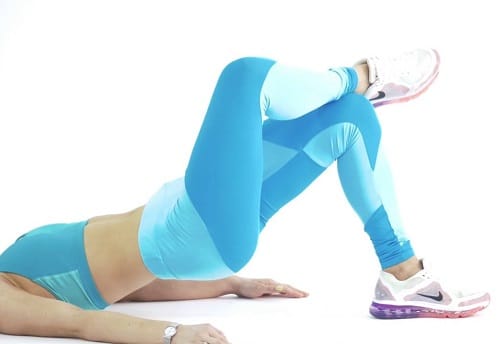
- Second option. Again, the starting position is lying on your back, one leg bent on the floor, the other straight extended upward. The technique is the same:
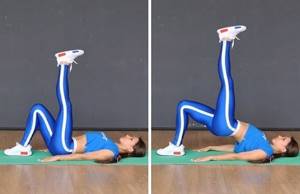
On fitball
A fitball (like other unstable support) is a good complication for the gluteal bridge. This way you will have to additionally concentrate on balance and the stabilizing muscles will come into play.
- First way. The shoulders and shoulder blades are on the fitball, the legs are shoulder-width apart, and the feet are pressed to the floor. Exhale with effort and raise the pelvis, pausing for a couple of seconds at the highest point. Slowly return to the starting position.
In this version, the ball acts as a bench. Believe me, it is difficult to stay on such a support, but thanks to this, the stabilizing muscles are included in the work.
- Second way. We place our feet on a fitball and raise our pelvis until a straight line with our torso is formed. Keep your balance! Slowly, rolling the ball back, we return to the starting position.
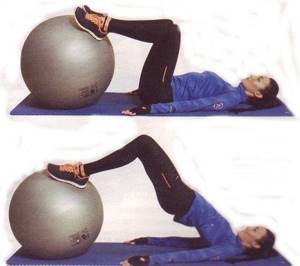
With weight
With dumbbells
The most obvious and fairly convenient weighting option. What we like about this option is that you can throw the weight on yourself without much difficulty. For example, lifting a barbell on your own is much more difficult!
The technique is not original: we lie down on the mat, bend our knees. We take a dumbbell in our hands and place it on our hips, holding it with our hands.
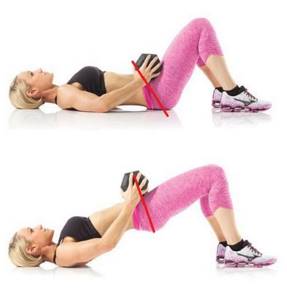
Raise the pelvis and remain in this position for 2-4 counts, with maximum tension. After this, we lower ourselves without touching the floor with our buttocks! Hold the weight with your hands the entire time you perform it so that the axis of the load does not shift from the buttocks.
You can also perform kettlebell on your butt!
With pancake
The technique for performing a pelvic lift with a weight plate is the same as with dumbbells. You can make it more difficult by doing it from a bench - this allows you to achieve greater amplitude!
Useful training video:
From the bench
There are 2 ways to sit on a bench: you lie down with either your upper or lower body on an elevation - the main thing is to make it comfortable and safe:

What is important to consider:
- It is also important to consider: this option of lifting the pelvis with emphasis on a bench is possible without injury only for flexible people - if you have problems with this, it is better to abstain!
- Ideally, the required bench height is 40 cm . However, you should experiment with different benches to determine your individual, comfortable height, which will help you perform the exercise with maximum involvement of the gluteal muscles.
- The emphasis on the bench should be on the lower edge of the shoulder blades - so that when you lift, you can easily rest your shoulders on it.
- While lifting the barbell, you should not help yourself with your elbows or rest your neck against the support : this can lead to pinching of the muscles and blood vessels.
- If you have one bench in your room, but it doesn’t suit you, you can place a rug folded several times under your butt. If, on the contrary, you are already high, then take a banal step platform.
If you want to further complicate the technique of performing an exercise on a bench, use two elevations of the same height. This will increase the range of motion of your hips to perform a bridge, look at the photo:
You can also add a knee tuck at the peak point or lift one leg up for more work on each of the buttocks. You can also bend one leg at the knee and perform a pelvic lift, first on one leg, then on the other. Of course, these options are for experienced trainees!
In the leg curl machine
Lying pelvic lifts are a more advanced version of the gluteal bridge, which is performed on a lying leg curl machine. Don’t be afraid, this option has a big advantage: you can easily change the working weight and not be afraid of injury, because it is fixed.
You will also have a given trajectory of movement, so it will be easier to perform the exercise.
How to do:
- Lie with your shoulder blades on the edge of the machine bench. Place your legs shoulder-width apart and press your feet to the floor. The roller is located on the line of the hip bone . Hands are on the bolster, and the pelvis is in the canopy.
- Using the force of your buttocks as you exhale, lift your pelvis until it is parallel to your body. Hold for 2 seconds at the top and squeeze your buttocks tightly. Feel the tension in your muscles.
- Lower your pelvis slowly and under control, making sure that the tension does not go away from the muscles! Don’t fall like a fallen willow and don’t sit on the floor at the bottom of the exercise! Repeat as many times as necessary.
Visually:
With a bar and a barbell
Lifting the legs and pelvis with a barbell while lying down is the most inconvenient option, in our opinion. Because you have to independently support the weight of the barbell in the absence of a given amplitude - the possibility of injury is high.
What to pay attention to:
- There is only one correct position of the bar: on the bend of the legs and body .
- As you perform the movement, make sure that the bar does not roll forward or backward across your body.
- It is strictly forbidden to place the barbell on your stomach.
The technique for performing with a barbell is the same as without a barbell.
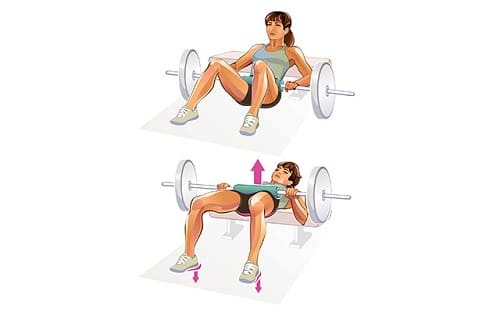
There are 2 types of bars: Olympic long bar weighing 20 kg and curved short bar from 10 kg. We recommend that you use the second type. But no matter which one you choose, remember that if you feel uncomfortable, painful or uncomfortable, you can put a cushion or towel under it.
People often ask how to lift a barbell? Ideally, the safest and most convenient option is to have someone put it on you, but if a faithful friend is not nearby:
- “Roll up” the barbell over your outstretched legs, if the height of the plates allows you to do this (classic - from 10 kg, crossfitter - from 5 kg),
- place a barbell with a small weight on your hips while sitting on a bench and step down from the bench,
- place a barbell or step platform on both sides - this will create additional space between the bar and the floor,
- overcome your shyness and ask the most handsome guy in the room to help you!
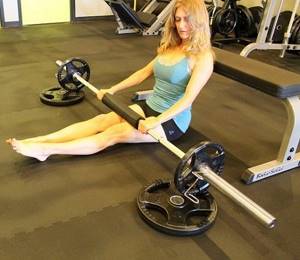
It is most convenient to perform a gluteal bridge with a barbell on a bench:
In the Smith machine
We place a bench next to the machine and lie down on it so that the fulcrum is on the shoulder blades, and the bar is on the line of the hip bone . We recommend that you hold onto the bench with your hands - this will make it easier to make effort when lifting the weight.
Starting position: legs bent and standing shoulder-width apart, toes turned out, pelvis tilted. By tensing the gluteal muscles, we raise the hips to a straight line with the body. At the final point, we linger for a few seconds, squeezing the muscles, then slowly lower ourselves without relaxing.
Do not hold your breath: as you exhale, raise your pelvis, while inhaling, lower it.
The Smith pelvic lift is ideal for those just starting to exercise and those who have poor balance.
Which glute bridge option is best? In fact, each of them is good and effective in its own way: the selection criteria are your comfort, personal preferences and the availability of equipment.
Glute bridge on a bench
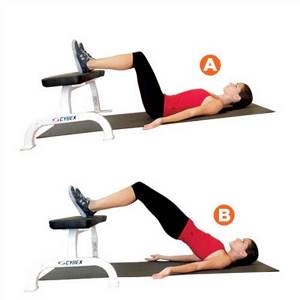
Elevation increases the range of motion when performing the exercise, and also helps to increase the load. That's what a bench is for.
There are two ways to perform a glute bridge on one leg from a bench:
- The upper body and shoulders are placed on the bench. One leg is fixed on the floor, the second remains straightened or on the other leg. The lower back should not bend. Inhale and lift your buttocks, holding them in the air for a while. Then, as you exhale, return to the starting position.
- The body lies on the floor. The legs are positioned similarly, only now on the bench. As you inhale, you need to raise your pelvis, and as you exhale, lower yourself back down.
With an emphasis on the bench, a gluteal bridge with a barbell is also performed.
Glute bridge on a fitball

If the training takes place in the gym, then you can replace the bench with a fitball. The following must be done:
- Body on the floor, one leg on a fitball, bent at the knee.
- Raise your pelvis to a straight line, holding the position for a while.
- Return to previous position.
There is also another version. The shoulder blades are placed not on the floor, but on a fitball. Then the straight line runs at the level of the shoulder blades.
Variations of the exercise
To prevent working muscles from adapting so quickly to the same type of load, it is important to alternate exercises. Variations differ in the technique of execution, the weight used, the number of approaches, they introduce the necessary variety into the training process, keeping the whole body in constant tone. They are suitable not only for women, but also for men. The most popular exercise options for the buttocks among fitness enthusiasts and professional athletes are:
- bridge with dumbbells or a weight plate;
- from the bench;
- on straight arms;
- with a barbell;
- in the Smith machine (option for girls);
- with support on one leg;
- in a leg curl machine;
- return bridge.
A glute bridge with dumbbells or a weight plate is performed like this:
- Starting position: lying on the floor, knees bent, feet shoulder-width apart, back neutral. Dumbbells are held by the thighs.
- The pelvis moves upward. At the highest point, the body is statically delayed (for 1–2 seconds), while the muscles are maximally tense.
- The pelvis smoothly returns back.
- When working with dumbbells, it is important to start with a small weight and gradually increase the load. Perform 3-4 sets of 10-12 repetitions.
The gluteal bridge with a barbell requires special sports training. It is recommended to perform it under the supervision of a trainer, which will avoid injury. Suitable for women. Technique for performing a gluteal bridge with a barbell:
- The starting position of the body is that the shoulders and shoulder blades are pressed tightly against the bench.
- The barbell is placed on the hips. For comfort, use a special cuff or rolled towel.
- Legs rest on the floor, feet shoulder-width apart. The hips are smoothly raised up. The body should form a straight line parallel to the floor. Hold the bar for 1–2 seconds.
- Smoothly lower the pelvis down, not reaching the floor 5 cm. At the same time, the buttocks are compressed and tense.
- Perform 3-4 sets of 15 repetitions.
The Smith glute bridge differs from the glute bridge with a barbell on a bench in the preliminary preparation of the sports equipment. Before taking the starting position, the horizontal bench is installed parallel to the barbell in the simulator no further than 40–50 cm. It is important to correctly adjust this distance so that the shoulder blades are located comfortably, relieving all tension from the cervical region. Next you need to repeat the steps described above.
The glute bridge on one leg is performed both with weights and with your own weight. Starting position: lying on the floor, knees bent, feet resting on the floor shoulder-width apart. One leg is raised up, the knee is placed closer to the chest. The pelvis is smoothly raised, held (1-2 seconds) and slowly lowered down. A bridge with one supporting leg is difficult to perform, since it also adds control of body balance. The exercise is suitable for women and men.

With dumbbells or a weight plate
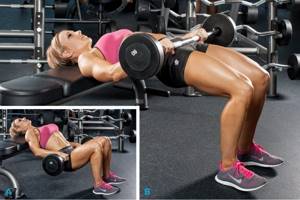
With a barbell
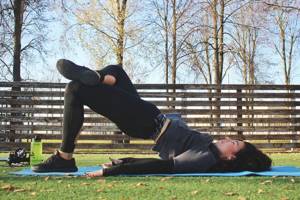
On one leg

With elastic band
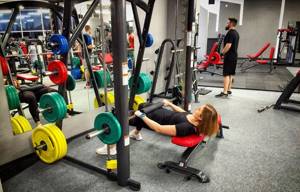
In Smith
What muscles work
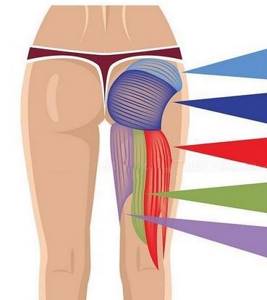
You need to know which muscles work in a particular exercise. The exercise is isolating.
The following muscles are involved during conduction:
- gluteal;
- spinal extensors;
- rectus abdominis muscle;
- quadriceps femoris muscle.
If the rules are followed, the load is placed on the back, which eliminates lower back pain.
Benefit
- the ability to load the buttocks without putting stress on the lower back (unlike squats),
- the gluteal bridge has a simple technique, so usually even beginners do not have any difficulties,
- the abdominal muscles are additionally strengthened,
- and also stretches the back of the thigh,
- variability: you can perform the exercise with your own or free weight even at home, as well as in the simulator,
- improved tone (due to blood circulation) of the pelvic organs and increased libido.
Nuances
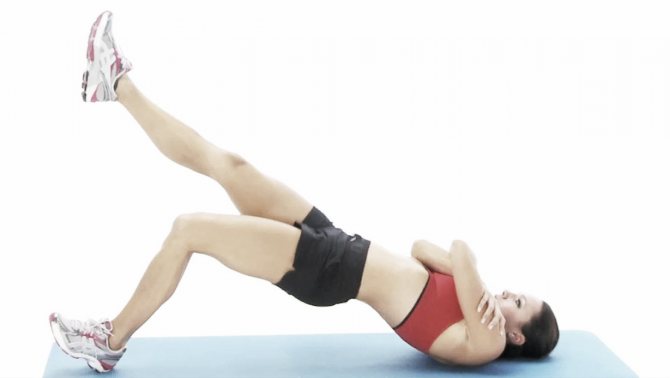
It should be borne in mind that the exercise is not basic. It is recommended to include it in the complex. Particularly effective after squats and before abdominal exercises.
At this moment, the buttock muscles are warmed up, and the bridge will help improve and consolidate the result. There are a number of features and recommendations that are especially useful for beginners.
When performing the exercise, remember the following:
- The legs are located at the optimal distance from the body. If positioned incorrectly, the quadriceps muscles will be involved. Find the ideal angle between your thigh and shin.
- When raising your pelvis, do not lift your foot off the floor. The weight must be transferred to the heel, which will increase the load on the muscles. The body must be raised as high as possible.
- The muscles are tense in all phases of the exercise. When returning to the starting position, the buttocks cannot be relaxed, otherwise there will be practically no difference before and after training.
- When performing, it is not necessary to avoid overloading the neck muscles, as there is a risk of damage to the nerve endings.
- The increase in repetitions and load occurs gradually. You can't let your buttocks get exhausted.
Also, everyone should remember that every workout begins with a warm-up and ends with stretching.
What to replace
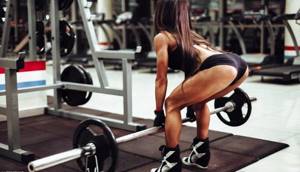
The one-leg gluteal bridge is sometimes replaced with the classic version, using a barbell or dumbbells. It is not recommended to completely exclude this exercise, since in combination it brings quite a good effect.
If for some reason it needs to be excluded, then there are other exercises that affect the muscles of the buttocks and legs:
- squats;
- plie squats with dumbbells;
- Romanian deadlift (including on one leg);
- lunges;
- squats with one leg on a bench;
- leg press with wide feet;
- moving the leg back.
Such exercises have a comprehensive effect on the gluteal muscles. Some of them can be performed not only in the gym, but also at home.
Reviews
Based on feedback from visitors to the hall, we have compiled the main and most important advantages of this exercise:
Marina: I have very big problems with my knees and this is practically the only exercise that the doctor and trainer allow me to do to lift my buttocks!
Bone Wide: yes, the load on the knee joint in the gluteal bridge is not axial and is minimal. So if your knees hurt when squatting, then don’t worry, there will be no pain in this exercise even with weights. The same applies to back problems. There is no axial load on the spine, which means that pelvic lift can be performed for protrusions, hernias and other back problems (but after consulting a doctor).
Olga: I’ve been doing glute bridges for a couple of months now, I’ve eliminated squats and you know, varicose veins have stopped bothering me as much as before.
Broad Bone: Again, we repeat that there is no axial or impact load during this exercise (as when running or jumping) and does not create a lot of tension in the legs (as when doing squats with weights or other movements performed while standing). So varicose veins are not a problem here!
The truthful answer: is it possible to play sports with varicose veins?
